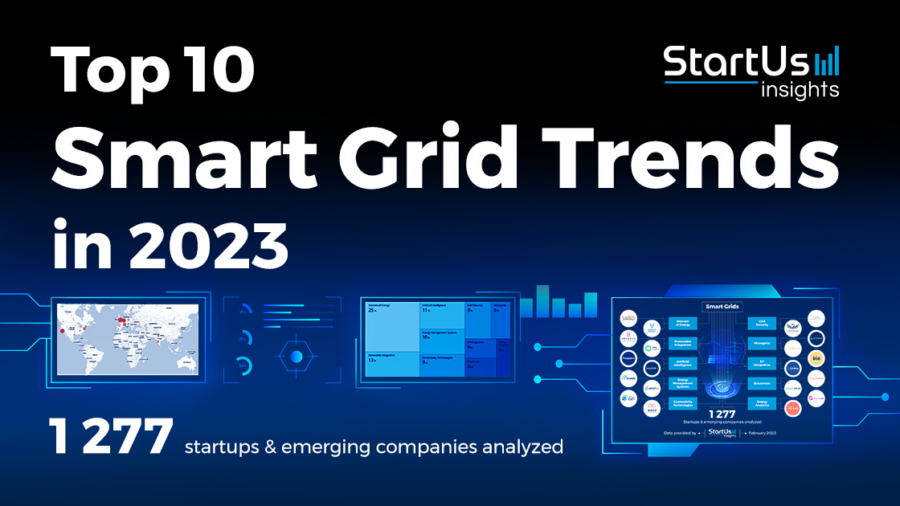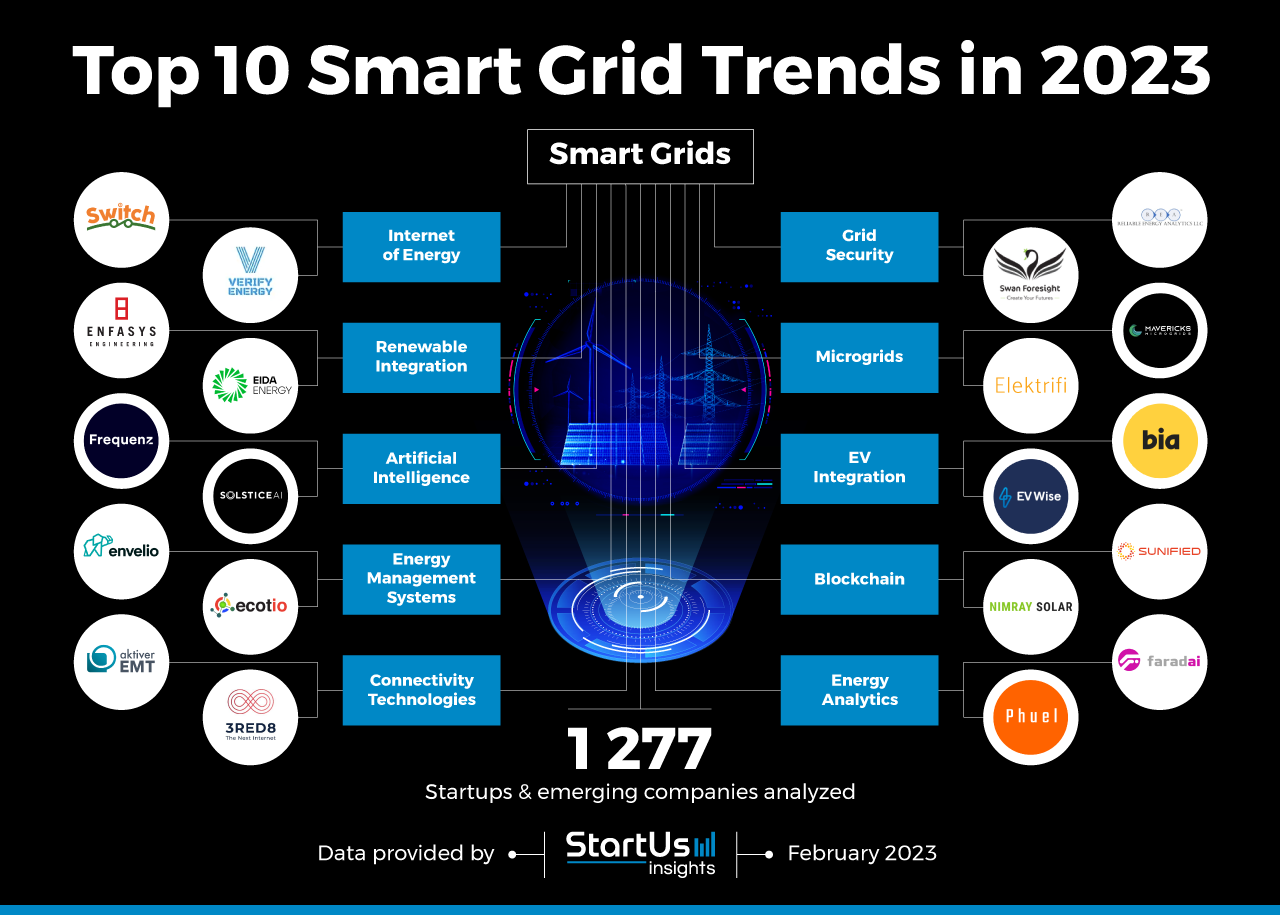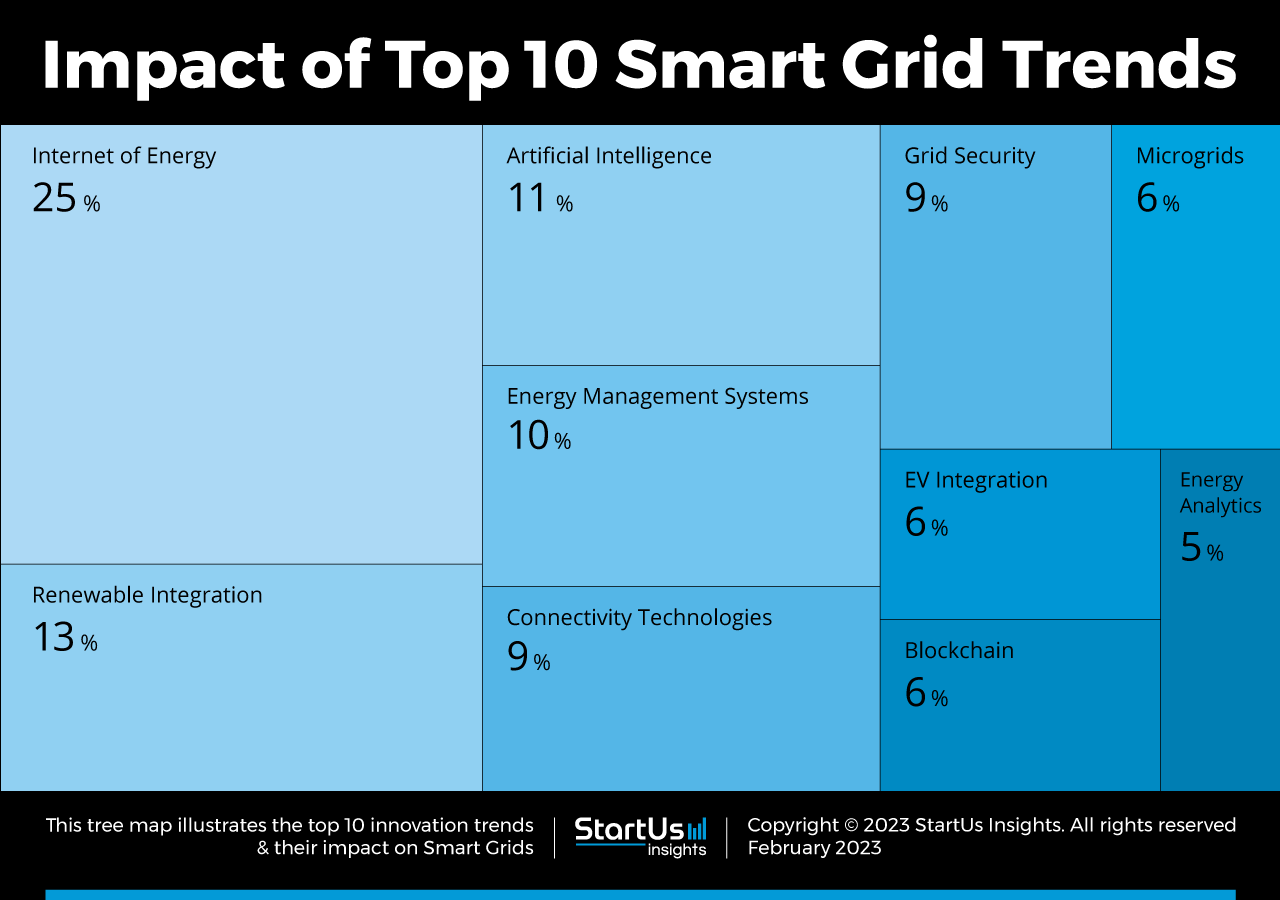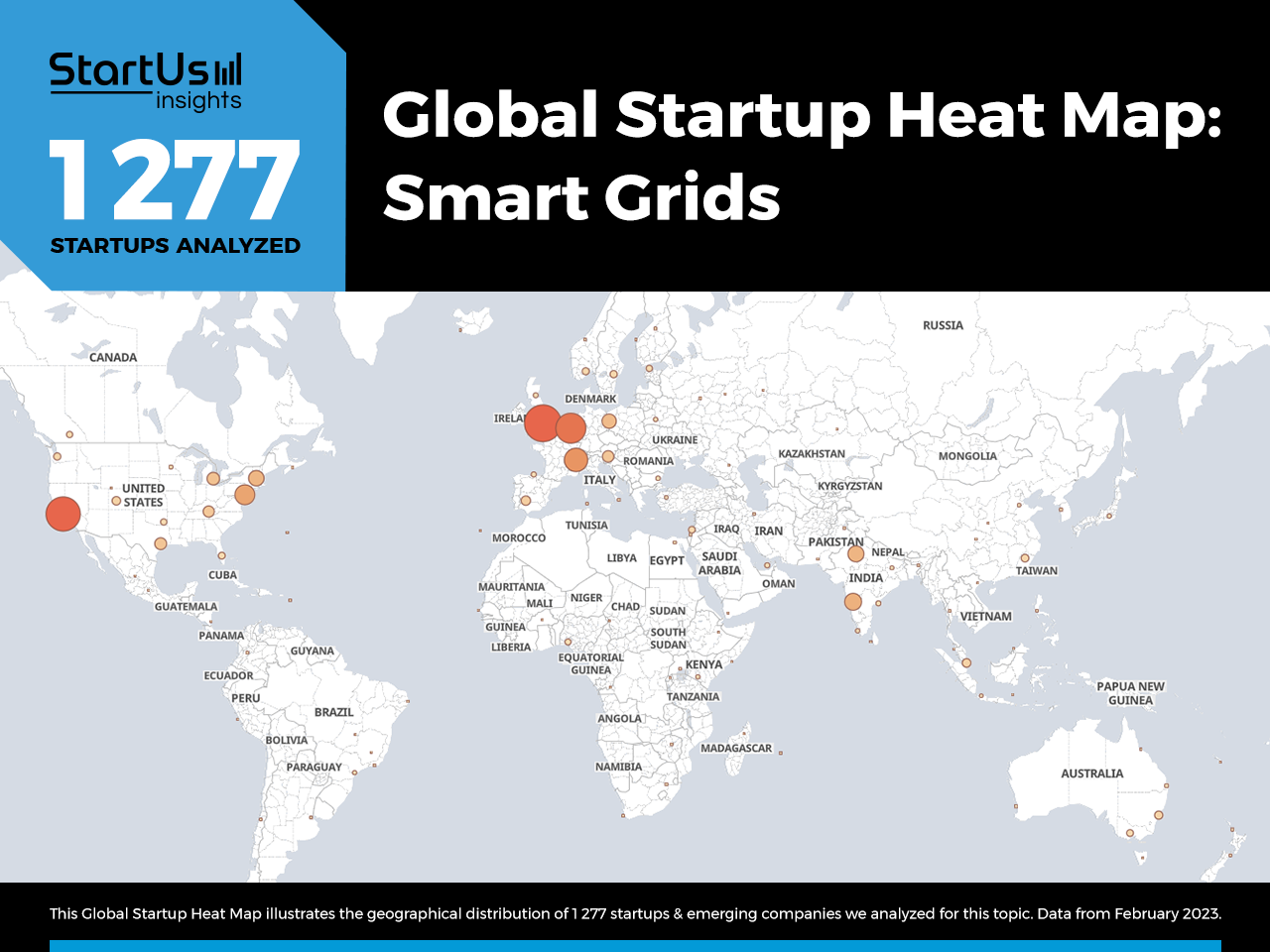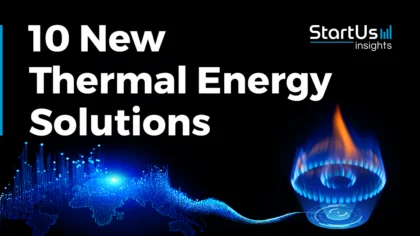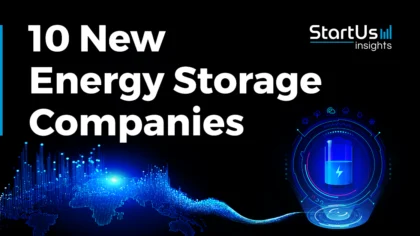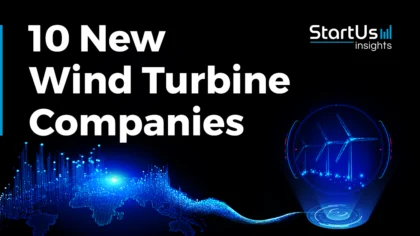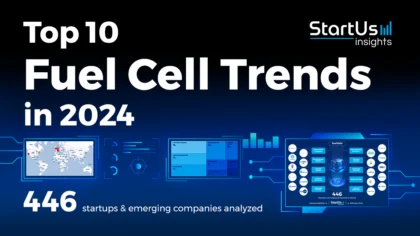Innovations in the internet of things (IoT), renewables, and artificial intelligence (AI) are improving grid efficiency, environmental friendliness, and reliability. Utilities are increasingly using smart meters to gather real-time energy consumption data while enabling consumers to better manage their energy use. Integration of green power sources into power grids makes them more sustainable and improves demand-side management. This research provides an overview of the top 10 global smart grid trends based on the analysis of 1 277 startups working in the field. They include the internet of energy (IoE), energy management systems (EMS), 5G, and more. Read more to explore all trends and discover how they impact your business.
Innovation Map outlines the Top 10 Smart Grid Trends & 20 Promising Startups
For this in-depth research on the Top Smart Grid Trends & Startups, we analyzed a sample of 1 277 global startups & scaleups. The result of this research is data-driven innovation intelligence that improves strategic decision-making by giving you an overview of emerging technologies & startups in the energy utility industry. These insights are derived by working with our Big Data & Artificial Intelligence-powered StartUs Insights Discovery Platform, covering 3 790 000+ startups & scaleups globally. As the world’s largest resource for data on emerging companies, the SaaS platform enables you to identify relevant startups, emerging technologies & future industry trends quickly & exhaustively.
In the Innovation Map below, you get an overview of the Top 10 Smart Grid Trends & Innovations that impact 1 277 companies worldwide. Moreover, the Smart Grid Innovation Map reveals 20 hand-picked startups, all working on emerging technologies that advance their field.
Top 10 Smart Grid Trends in 2023
- Internet Of Energy
- Renewable Integration
- Artificial Intelligence
- Energy Management Systems
- Connectivity Technologies
- Grid Security
- Microgrids
- EV Integration
- Blockchain
- Energy Analytics
Tree Map reveals the Impact of the Top 10 Smart Grid Trends
Based on the Smart Grid Innovation Map, the Tree Map below illustrates the impact of the Top Smart Grid Trends in 2023. Startups and scaleups are developing technological solutions for improving power consumption monitoring and grid sustainability. IoT enables real-time monitoring of distributed energy resources (DERs) through sensors and smart meters. Renewable and electric vehicle (EV) integration allows energy companies to better manage peak loads. Additionally, AI and EMS enable outage and load prediction in real-time, leading to increased efficiency, reliability, and cost savings. Moreover, grid security and blockchain solutions reduce grid vulnerability to cyber-attacks by delivering secure and decentralized payment gateways and data storage. The deployment of microgrids also enables decentralized energy production to increase grid resilience and improve energy access. Lastly, energy analytics helps grid operators and energy providers better understand consumption patterns and identify bottlenecks or asset issues.
Global Startup Heat Map covers 1 277 Smart Grid Startups & Scaleups
The Global Startup Heat Map below highlights the global distribution of the 1 277 exemplary startups & scaleups that we analyzed for this research. Created through the StartUs Insights Discovery Platform, the Heat Map reveals that high startup activity in Europe and USA, followed by India.
Below, you get to meet 20 out of these 1 277 promising startups & scaleups as well as the solutions they develop. These smart grid startups are hand-picked based on criteria such as founding year, location, funding raised, & more. Depending on your specific needs, your top picks might look entirely different.
Top 10 Smart Grid Trends in 2023
1. Internet Of Energy
The integration of IoT devices into energy grids enables real-time energy monitoring and control. IoT-based sensors help grid operators prevent energy theft, negating losses to the energy sector. On the other hand, enabling remote control through IoT allows utilities to restrict energy access while consumers and businesses use it to control smart devices. IoT thus simplifies grid asset monitoring by collecting real-time data, which further enables preventative maintenance with data processing technologies. On the consumer side, smart meters improve the accuracy and efficiency of energy consumption monitoring to save energy. These IoT solutions and the data from smart meters allow utilities and grid operators to optimize energy distribution and reduce energy wastage.
Switch Electric offers a Smart Meter for Decentralized Energy Projects
Nigerian startup Switch Electric develops a prepaid smart meter for decentralized energy projects. The startup also offers a software control panel and a companion smartphone application, Switch Mobile, to enable backend analytics and diagnostics. With its smart alerts, theft detection, and anomaly detection features, utilities monitor energy usage and detect suspicious activities. The smart meter features remote asset administration for utilities to manage them from a central location. The smartphone app also allows users to track electricity consumption and make payments on the go.
Verify Energy develops IoT-based Smart Grid Monitoring Software
US-based startup Verify Energy creates Powerfly, a IoT monitoring software. It is a comprehensive monitoring and control platform for clean energy devices, designed specifically for commercial and industrial markets. Clean energy providers install the startup’s universal gateway device to connect to the Powerfly software. It features cloud-based controls and local real-time controls to support situations needing power export limiting (PEL) and other safety measures. The device then enables two-way communication capabilities for the asset managers to control clean energy assets locally or through the cloud. This simplifies the management of clean energy projects for asset managers by providing an affordable, customizable, and scalable monitoring solution for entire portfolios.
2. Renewable Integration
Sourcing energy from renewable sources for grid operations reduces the dependence on carbon-intensive energy sources. This also aids smart grids in demand response management during peak hours, preventing grid congestion and blackouts. Energy storage systems (ESSs), such as grid-scale batteries and pumped hydro-storage, allow energy companies to mitigate the intermittency of renewable energy sources. Smart grids also leverage electric vehicle (EV) charging infrastructure to better manage grid load. To aid this, startups are developing smart inverters and energy storage systems tailored for grid applications. These systems help balance the energy supply and demand, enabling utilities to manage energy flow effectively.
ENFASYS Engineering aids Power Flow Management
Spanish startup ENFASYS Engineering offers Enfyo, a power flow management solution for energy grids and DERs. It comprises software tools and electronic equipment. The platform enables the integration of renewable energy sources (mainly solar and wind) and battery-based ESSs. It also optimizes storage and generation facilities using data analytics and forecasting to minimize energy costs. The startup thus removes the dependence on traditional energy generation sources and reduces the risk of blackouts. Consequently, this enables grid operators and energy providers to better manage and monitor distributed energy resources.
EIDA Energy offers Renewable Battery Storage
Norwegian startup EIDA Energy specializes in the production and distribution of renewable energy to and from local smart grids. The startup manufactures solar panels and offers battery power storage units to reduce the dependence on traditional energy sources. This way, the startup reduces peak-hour capacity requirements to avoid transmission capacities and save costs. This also enables power grid companies to reduce tariffs for businesses and residents.
3. Artificial Intelligence
AI enables real-time monitoring, analysis, and control of energy generation and consumption assets within the smart grid. For instance, startups develop AI-powered solutions that simplify load forecasting. This allows energy companies to optimize energy distribution and improve grid management. Smart grids also leverage AI to predict equipment failure, allowing utilities to perform proactive maintenance. For this, AI analyzes data from sensors, energy management systems, and other connected devices such as transformers, circuit breakers, and power lines. Machine learning and deep learning algorithms utilize such historical data to detect patterns that indicate potential failures. Additionally, AI monitors energy production from renewable sources to effectively integrate them into the grid, optimizing energy sourcing and enabling virtual power plants (VPPs).
Frequenz builds a Microgrid Operating System (OS)
German startup Frequenz makes Frequency EDGE AI, an open-source, AI-based microgrid OS. It locally recognizes and connects to all microgrid components to collect relevant data. The OS then analyzes the data to provide actionable insights for better power management. By combining this data with external sources, including electricity market data, the startup’s self-learning AI delivers accurate load forecasts in real time. This results in reduced power usage during high load times and lower power costs for consumers. The OS’s open-source nature allows for modifications to be made in the OS by utilities and grid operators to suit specific microgrid requirements.
Solstice AI offers AI-powered Energy Forecasting
Australian startup Solstice AI leverages AI to offer accurate energy forecasts. The startup’s Solstice platform provides rooftop solar identification using satellite imagery. It utilizes AI to identify and forecast renewable energy generation sources within the smart grid. This enables more effective integration of renewable energy into the grid. The startup also uses socio-demographic data to identify neighborhoods that are ready to install more solar panels and facilitates their uptake. The identified sources are then connected to the larger grid to aid renewable integration and load sharing, improving grid stability.
4. Energy Management Systems
EMS solutions allow utilities and businesses to monitor, control, and optimize energy distribution. It also plays a critical role in demand response and renewable energy integration. Such systems help manage peak loads by balancing power generation and demand. The data from EMSs also allows utilities to forecast energy production and demand. Further, energy providers utilize EMS to improve voltage management and ensure optimal energy usage. Startups are also innovating with AI-powered EMS solutions that offer real-time data analysis and decision support. For the commercial sector, EMS allows businesses to better understand consumption patterns and reduce energy costs.
ECOTIO develops an Energy Management Platform
Indian startup ECOTIO makes an energy management platform that combines IoT and cloud computing to provide insights into energy consumption. With accurate and autonomous data collection, the platform makes it easy to track and analyze energy use. It also enables the analysis of power factor variation for individual machines and entire establishments. The platform features performance benchmarking to compare energy consumption for multiple machines and devices. This aids in verifying the impact of energy-saving measures on them. As a result, the startup’s platform allows utilities and energy providers to better manage energy supply and demand and ensure effective demand response programs.
envelio offers an Intelligent Grid Management Platform
German startup envelio provides an intelligent grid management platform. It combines grid data from sensors and automates grid planning and monitoring. The platform automates processes like the integration of new distributed generators, battery storage, and consumers into the grid. It also supports grid forecasting and provides insights to manage maintenance tasks, peak loads, and grid congestion. This allows utilities and energy providers to leverage real-time grid monitoring and planning.
5. Connectivity Technologies
Connectivity technologies, such as low-power wide area networks (LoRaWAN) and 5G, provide the necessary infrastructure to connect smart grid components. These technologies enable utilities to leverage real-time asset and energy data critical for monitoring and managing electricity distribution. Additionally, smart grids now accelerate 5G integration to enable low-latency communication between smart devices, sensors, and central management systems. This aids grid management and ensures near real-time monitoring of energy usage, faults, and asset conditions.
Aktiver EMT offers LoRaWAN-based Smart Submetering
German startup Aktiver EMT makes a smart submetering solution based on LoRaWAN. It ensures a higher transmission range, better building penetration, and increased energy efficiency compared to wifi. The startup’s smart meter gateway records consumption data and allows consumers to access this data remotely. It also monitors charging stations and renewable energy sources. The LoRaWAN network simplifies the integration of radio-capable smoke alarm devices and a range of smart home and smart building sensors to the grid. This connected ecosystem enables energy suppliers to use their existing systems to receive and manage real-time data on energy consumption without massive changes in infrastructure.
3Red8 builds a Smart Grid Communication Network
US-based startup 3Red8 creates a fiber-optic communication network for smart grids. The startup’s core network features a three-layer open access dark fiber to run coast-to-coast. This allows energy companies to scale grid operations and enable macrogrids. The network’s high-speed data transmission enables real-time data delivery, allowing energy providers to perform on-demand outage management to monitor and optimize power utilization.

6. Grid Security
The digitization of the grid increases the risk of cyberattacks against energy infrastructure. To tackle this, startups implement encryption protocols and other cybersecurity solutions to secure data transmission. This protects grid components like smart meters, control systems, and distribution networks. Grid security also focuses on intrusion detection systems (IDS) that monitor network traffic and identify unauthorized or suspicious activities. This way, energy businesses are able to automatically identify potential threats and accelerate threat detection and response efforts. Startups are also developing anti-theft, access control, and authentication solutions that mitigate in-house product development for energy companies, saving costs and time.
Swan Foresight develops a Smart Grid Security Module
Australian startup Swan Foresight creates a DER security module. Its cryptographic processor generates hashing algorithms to encrypt energy consumption data. The module also includes key management hardware and brute force attack protection components. They help to prevent cyberattacks by limiting the number of attempts to access connected energy assets. Swan Foresight also provides cybersecurity services such as data loss prevention and backup, asset management, and vulnerability scans. These solutions allow energy providers to safeguard smart grid systems from cyber attacks, unauthorized access, and other cybersecurity risks.
Reliable Energy Analytics offers Grid Authentication Software
US-based startup Reliable Energy Analytics develops Software Assurance Guardian (SAG), a smart grid authentication solution. It identifies harmful software objects in the energy grid based on the NIST cybersecurity framework. The software assesses the trustworthiness of software objects in the energy supply chain and provides a score across various risk categories across multiple factors. Once it identifies malicious software, SAG facilitates the reporting of cyber incidents to prevent malware spread. By identifying and reporting malicious software objects, the startup helps utilities and energy providers protect the energy grid against malicious attacks.
7. Microgrids
Microgrids provide localized energy generation and distribution capabilities to power remote locations. In rural areas, they deliver reliable and affordable electricity by utilizing local renewable energy sources such as solar, hydro, and wind power. This reduces the reliance on fossil fuels and minimizes transmission losses over long distances. Moreover, utilities leverage microgrids to provide backup power during grid outages, which is crucial for hospitals, data centers, and other mission-critical infrastructure. Some startups are also developing microgrid systems tailored for urban applications. This reduces the strain on the main grid and ensures continuous power delivery for mission-critical infrastructures.
Mavericks builds Carbon Neutral Microgrids
US-based startup Mavericks specializes in the development, financing, and operation of carbon-neutral and carbon-negative microgrids and VPPs. The startup’s offerings include all-electric solar-powered smart homes, on-site microgrid power for industrial sites, and EV chargers integrated into the grid. It also provides EV as a service for demand-side management and load reduction. Energy providers use Mavericks’ cost-effective microgrid solutions to improve energy demand response, reduce carbon emissions, and enhance their sustainability profile.
Elektrifi Technologies develops Rural Microgrid Solutions
US-based startup Elektrifi Technologies develops microgrid solutions for rural applications. The startup’s small-scale microgrids power critical infrastructure to reduce outages during disasters and man-made events. It also integrates energy sources and batteries with communication and computing systems for energy metering, monitoring, and remote control. Further, Elektrifi’s cloud platform integrates devices and sensors, facilitates fleet management, and allows users to remotely access their grid data through global cellular connectivity. This enables utilities to reduce electricity outages in remote locations and advance asset monitoring capabilities.
8. EV Integration
Utilities are now integrating electric vehicles into smart grids to enable vehicle-to-grid (V2G) connectivity and improve demand response. V2G allows EVs to return electricity to the grid during times of high demand. This helps balance the load on the grid and reduces the dependence on expensive power plants for energy sourcing. On the other hand, EV-driven demand response allows vehicle owners to charge their vehicles during off-peak hours, saving costs for them while aiding grid balancing. This optimizes grid resources and prevents blackouts. Grid-integrated EV charging infrastructures also provide ancillary services such as frequency regulation and voltage support.
Bia offers an EV Charging Platform
Spanish startup Bia creates an EV charging platform. The startup maintains EV charging stations and offers EV charging data services to a variety of sectors including energy retailers and utilities. The platform also provides energy forecasting and simulation for EV load modeling and planning. These simulations enable utilities to develop strategic EV charging plans that mitigate unnecessary costs and pitfalls. Its optimized EV charging algorithm charges with renewable sources, reducing power costs and smoothening peak loads.
EV Wise develops Automated EV Charging Stations
Dutch startup EV Wise provides automated EV charging stations. The startup manages the supply of green energy, charging hardware, and accompanying asset maintenance. EV Wise also utilizes algorithms and data analytics to predict when EVs need to charge, allowing for optimal charging profiles. The startup then delays charging until the most cost-effective or sustainable energy sources are available. This ensures that vehicle owners charge their EVs with minimal costs and the least impact on the smart grid. EV Wise automatically redirects vehicle charging times for low power demand periods when renewable energy is available. This reduces reliance on non-renewable sources and saves costs.
9. Blockchain
Blockchain manages and secures data flow within the grid, improving the transparency and security of energy transactions. Utilities also utilize blockchain solutions to create decentralized energy markets. Energy producers and consumers engage in peer-to-peer (P2P) energy trading, allowing for a more efficient and transparent system. This eliminates the need for intermediaries and saves costs for both energy companies, prosumers, and consumers. Also, implementing blockchain in energy management systems facilitates real-time billing and payments. Some startups are developing blockchain platforms tailored for decentralized energy generation and distribution projects that are critical for stabilizing the grid.
Sunified Group makes a Blockchain-based Grid Stabilization Sensor
Dutch startup Sunified Group makes UNITY, a solar grid stabilization sensor powered by blockchain. It attaches to solar panels to create immutable real-time records of power generation data. The startup stores the data captured from the panels in a blockchain ledger, enhancing transparency and security. This data enables accurate grid monitoring and balancing, advancing energy transition.
NimRay SOLAR maintains a Solar Energy Network
Indian startup NimRay SOLAR builds smart solar panels and a blockchain-based energy network, NIMRAY NETWORK. The startup supplies both solar panels and an accessible energy network that allows home energy generators to trade clean electricity. After the installation of solar panels, prosumers sign up on the network as energy producers or consumers. The startup then creates a virtual microgrid on the premises and connects the consumers to their nearest microgrid. This enables NimRay SOLAR to supply clean power while storing the transaction data on a blockchain ledger. Moreover, the startup supports both legacy and smart grids, allowing energy providers to quickly establish a profitable local energy network.
10. Energy Analytics
Smart grids generate massive amounts of data on energy consumption and connected assets like distribution networks and equipment conditions. Energy analytics solutions leverage this data to deliver insights into energy generation and consumption patterns, weather, and equipment performance. Startups are leveraging big data and analytics tools to manage and analyze this data and provide real-time insights and predictions to support decision-making. Using data analytics platforms, energy providers accurately predict energy demand, allowing them to improve grid balancing. Such solutions also facilitate the integration of renewable energy sources into the energy grid. Likewise, some startups develop analytics solutions that monitor energy consumption patterns to detect energy theft.
Phuel enables Remote EV Charging
Brazilian startup Phuel offers a remote cloud-based EV recharge platform. It leverages AI, big data, and analytics to analyze charging data and enhance the efficiency of EV recharge stations. The platform integrates various IoT devices such as plug-in EVs and recharge stations with commerce points. It then analyzes this information to identify patterns to avoid inefficient consumption at peak load times. This results in improved energy efficiency, grid stability, and cost savings.
Faradai aids in Energy Management
UK-based startup Faradai provides an energy management platform for smart grids. It monitors, analyzes, and manages energy demand, consumption, and emissions. The platform connects smart meters and grid assets to deliver real-time insights using big data and analytics. For this, it leverages data from various sources, including weather, utility bills, and renewable energy assets. This provides energy savings opportunities, improves operational efficiency, optimizes energy procurement, and enables predictive maintenance. Faradai’s energy management software thus allows energy businesses to detect problems related to power quality, installation, and maintenance.
Discover all Smart Grid Trends, Technologies & Startups
Due to increasing demand for clean grids, traditional energy grids are undergoing a massive overhaul. AI, IoT, nano grids, and blockchain, among other technologies, are accelerating this transition and making grids more responsive. Swarm grids are also gaining interest as they use networks of decentralized energy generators to dynamically adjust to energy demand. Quantum energy grids, on the other hand, leverage the principles of quantum mechanics to optimize energy transmission and storage.
The Smart Grid Trends & Startups outlined in this report only scratch the surface of trends that we identified during our data-driven innovation & startup scouting process. Among others, modular grid designs, real-time network monitoring, and 5G will transform the sector as we know it today. Identifying new opportunities & emerging technologies to implement into your business goes a long way in gaining a competitive advantage. Get in touch to easily & exhaustively scout startups, technologies & trends that matter to you!
